CAA News Today
Apply for CAA Committee Service!
posted by CAA — June 23, 2024
Join one of CAA’s twelve Professional Committees, the Annual Conference Committee, or the Publications Committee as an at-large member! Each committee works from a charge established by the Board of Directors. For many CAA members, committee service fosters professional relationships, community, and facilitates impactful contributions to pressing issues in the visual arts and higher education.
Important Committee Service Information:
- Committee members serve a three-year term. Service for this committee cycle begins in February 2025 at the CAA 113th Annual Conference and concludes in February 2028 at the 116th Annual Conference.
- All applications are reviewed by current committee members as well as CAA leadership.
- Appointments will be announced by November 1, 2024. New members will be introduced to their committees during their respective business meetings at the 113th Annual Conference in New York City (February 12–15, 2025).
- If appointed, applicants are expected to attend committee meetings, participate actively in the work of the committee, and contribute expertise to defining the current and future work of the committee.
- Appointees must be current CAA members before the start of their committee service, but do not need to be CAA members to apply.
- All committee members volunteer their service without compensation.
Visit our website using the links below to review the mission of each committee as well as the current roster of committee leadership and members.
CAA ANNUAL CONFERENCE COMMITTEE
The Annual Conference Committee is responsible for shaping the program of the Annual Conference, ensuring that the program reflects CAA’s goals: to make the conference an effective place for intellectual, aesthetic, and professional learning and exchange, to reflect the diverse interests of the membership, and to provide opportunities for participation that are fair, equal, and balanced.
CAA PROFESSIONAL COMMITTEES
CAA’s twelve Professional Committees represent the constituent interests of the organization by addressing standards, practices, and guidelines in the professions of our individual and institutional members.
- Committee on Design
- Committee on Diversity Practices
- Committee on Intellectual Property
- Committee on Research and Scholarship
- Committee on Women in the Arts
- Education Committee
- International Committee
- Museum Committee
- Professional Practices Committee
- Services to Artists Committee
- Services to Historians of the Visual Arts Committee
- Student and Emerging Professionals Committee
CAA PUBLICATIONS COMMITTEE
The Publications Committee oversees CAA’s publishing activities and supervises the editorial boards of The Art Bulletin, Art Journal/AJO, and caa.reviews.
Please Note: At-large members of the Publications Committee represent the voice of our membership, and perform the role of committee secretary, taking minutes at three Publications Committee meetings per year in February, May, and October.
If you are interested in applying to serve on a CAA committee, please click the APPLY TO SERVE button below to fill out the application form and upload your CV as well as a brief personal statement describing your interest and experience. If you are applying to more than one committee, please submit a separate personal statement tailored to each of the committees to which you are applying, noting why you’d like to serve on that specific committee.
Contact Maeghan Donohue, CAA Chief of Staff and Director of Strategic Planning, Diversity & Governance with any questions.
Deadline: August 8, 2024
Deadline Extended: CAA Conversations Call for Season 9 Podcast Participants
posted by CAA — June 05, 2024
Do you have an idea for a podcast or want to turn your conference panel into a podcast discussion? CAA Conversations is currently accepting applications to participate in its 9th season!
CAA Conversations is a podcast initiative run by the Education Committee and provides a platform to explore hot topics in the field. While not limited to these topics and open to new ideas, the podcast team is interested in exploring the following themes in season 9:
- Inclusive pedagogy/community building
- Interdisciplinary teaching
- New technologies
- Equity in art history and studio art classrooms
Contact CAA Education Committee podcast administrators with any questions here.
If you are interested in participating in our upcoming season, please submit an interest form here.
Deadline: June 30
Apply for CAA Committee Service!
posted by CAA — July 07, 2023
Join one of CAA’s twelve Professional Committees, the Annual Conference Committee, or the Publications Committee as an at-large member! Each committee works from a charge that is established by the Board of Directors. For many CAA members, committee service fosters professional relationships, community, and facilitates impactful contributions to pressing issues in the visual arts.
Important Committee Service Information:
- Committee members serve a three-year term. Service for this committee cycle begins in February 2024 at the CAA 112th Annual Conference and concludes in February 2027 at the 115th Annual Conference.
- All applications are reviewed by current committee members as well as CAA leadership.
- Appointments will be announced by November 1, 2023. New members will be introduced to their committees during their respective business meetings at the 112th Annual Conference in Chicago.
- If appointed, applicants are expected to attend committee meetings, participate actively in the work of the committee, and contribute expertise to defining the current and future work of the committee.
- Appointees must be current CAA members before the start of their committee service.
- All committee members volunteer their service without compensation.
Click the links below to review the mission of each committee as well as the current roster of committee leadership and members:
CAA ANNUAL CONFERENCE COMMITTEE
The Annual Conference Committee is responsible for shaping the program of the Annual Conference, ensuring that the program reflects CAA’s goals: to make the conference an effective place for intellectual, aesthetic, and professional learning and exchange; to reflect the diverse interests of the membership; and to provide opportunities for participation that are fair, equal, and balanced
CAA PROFESSIONAL COMMITTEES
CAA’s twelve Professional Committees represent the constituent interests of the organization by addressing standards, practices, and guidelines in the professions of our individual and institutional members.
- Committee on Design
- Committee on Diversity Practices
- Committee on Intellectual Property
- Committee on Research and Scholarship
- Committee on Women in the Arts
- Education Committee
- International Committee
- Museum Committee
- Professional Practices Committee
- Services to Artists Committee
- Services to Historians of the Visual Arts Committee
- Student and Emerging Professionals Committee
CAA PUBLICATIONS COMMITTEE
The Publications Committee oversees CAA’s publishing activities and supervises the editorial boards of The Art Bulletin, Art Journal/AJO, and caa.reviews.
Please Note: At-large members of the Publications Committee represent the voice of our membership, and perform the role of committee secretary, taking minutes at three Publications Committee meetings per year in February, May, and October.
How to Apply for Committee Service
If you are interested in applying to serve on a CAA committee, please click the APPLY TO SERVE button below to fill out the application form and upload your CV as well as a brief personal statement describing your interest and experience.
Deadline: September 15, 2023.
CAA’s Committee on Women in the Arts, Archival Recordings from the 1994 Annual Conference
posted by CAA — August 18, 2022
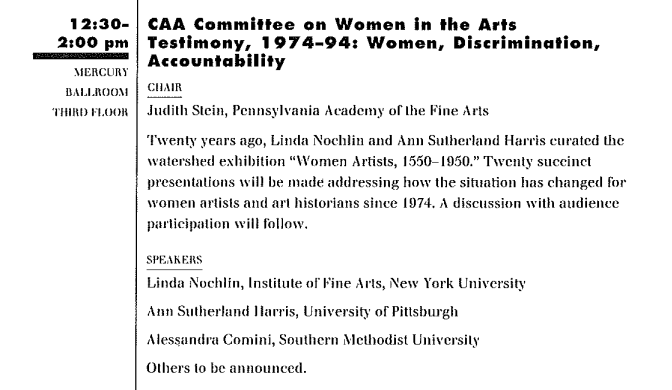
Entry in 1994 Annual Conference program of the Committee on Women in the Arts’ session.
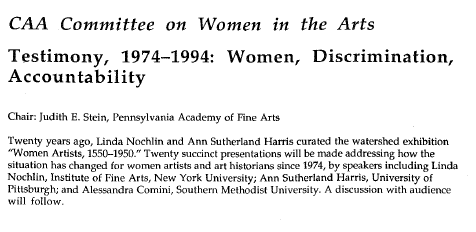
Abstract entry of the Committee on Women in the Arts session in the 1994 Annual Conference abstracts program.
Fifty years ago in 1972, CAA founded its first committees devoted to women in the arts. This year we celebrate the 50th anniversary of this history by sharing historic materials from CAA members and archives that intersect with feminism at the organization, CAA’s Committee on Women in the Arts, and from its Affiliated Societies, the Women’s Caucus for Art (WCA) and The Feminist Art Project (TFAP). CAA established the Committee on the Status of Women (COSW), the first committee to focus on women in CAA’s history, in 1972. The COSW was renamed the Committee on Women in the Arts (CWA) in 1996, and it continues to promote women in the visual arts field.
In 1994, CAA’s Committee on Women in the Arts held a panel chaired by Judith Stein that featured speakers Linda Nochlin, Ann Sutherland Harris, and Alessandra Comini. Their individual presentations look at the progress of women artists and art historians over the previous twenty years, since 1974. The talks use the exhibition, Women Artists 1550-1950, curated by Nochlin and Harris, as a benchmark for discussion. This landmark exhibition toured four American museums in 1976-77, such as the Brooklyn Museum in 1977, and raised public awareness of the many gifted women painters, sculptors, and architects.
The talks in this session compare and contrast the attitudes that prevailed when the show was being organized with views in the nineties. Releasing these recordings of the session almost another twenty years later, it is an opportunity to reassess the status of women in the arts once again.
Biographies of the speakers:
Judith E. Stein chaired CAA’s Committee on Women in the Arts from 1992 to 1997, initiating a series of awards to women in the arts. A writer and curator, Stein studied at Barnard College, and has a Ph.D. in art history from the University of Pennsylvania.
Stein was recently awarded the Lifetime Achievement Award by the Women’s Caucus for Art (WCA) in 2020. She has written at length on feminism and women artists, beginning with her 1981 doctoral thesis on the neoclassic iconography of Sappho, one of the first feminist dissertations in art history at the University of Pennsylvania. She helped organize Philadelphia Focuses on Women in the Visual Arts (FOCUS) in 1973-74 and edited the WCA’s newsletter from 1975 to 1977. She was also a member of the WCA national advisory board from 1979 to 1981. Her first piece of art criticism was published in Art in America in 1974, reviewing a Judy Chicago exhibition. She also wrote on Cecilia Beaux, the first woman to teach at the Pennsylvania Academy of the Fine Arts, Feminist Art Journal, Winter (1975–1976). Her work has also appeared in Art News, The New York Times Book Review, and the National Public Radio’s Fresh Air and Morning Edition.
Stein served on the advisory board of Philadelphia’s Leeway Foundation for women artists, (1994–2002) and was the first curator of Leeway Founder Linda Alter’s collection of art by American women artists. Stein wrote the foundational essay for Making Their Mark: Women Artists Move into the Mainstream, 1970–1985 (Abbeville, 1989) and “Collaboration,” for The Power of Feminist Art (Harry N. Abrams, 1994). She curated The Likeness of Being: Contemporary Self-Portraits by Sixty Women (DC Moore Gallery, New York, 2000), and co-curated Picturing the Modern Amazon: The Hypermuscular Woman (The New Museum of Contemporary Art, New York, 2000).
She is the author of Eye of the Sixties, Richard Bellamy and the Transformation of Modern Art, (Farrar, Straus & Giroux, 2016). Other curatorial projects by Stein include Red Grooms, A Retrospective for the Pennsylvania Academy of the Fine Arts, and I Tell My Heart: The Art of Horace Pippin, which traveled to the Metropolitan Museum of Art in 1995 and earned a best catalogue award from AICA/USA.
Among her honors is a Creative Capital/Andy Warhol Foundation Arts Writers Grant; a Pew Fellowship for literary non-fiction; and a Lannan Foundation writing residency in Marfa, Texas. Learn more about Judith Stein’s career on her webpage and in this WCA announcement.
Alessandra Comini is University Distinguished Professor of Art History Emerita at Southern Methodist University in Dallas, Texas. She received her B. A. degree from Barnard College, her M. A. from the University of California at Berkeley, and her Ph.D. “with distinction” from Columbia University where she taught for ten years. She has also taught at the University of California, Berkeley, Yale University, served as the Alfred Hodder Resident Humanist at Princeton University, and was named Distinguished Visiting Lecturer at Oxford University‘s European Humanities Research Centre (1996). Voted “outstanding professor” by her students sixteen times, she has been extended the Distinguished Teaching Prize of the Meadows School of the Arts and the United Methodist Church Scholar/Teacher of the Year Award (1996).
An undergraduate and a graduate scholarship in Comini’s name have been established by former students, one a professor of surgical oncology in Little Rock, Arkansas; the other, founder and co-owner of an international antiques business in Dallas. The author of major essays and eight books, one of them nominated for the National Book Award (see publications), Dr. Comini was awarded the Grand Decoration of Honor by the Republic of Austria in recognition of her contributions to Germanic culture in 1990. Her lively revisionist work in the history of women artists was acknowledged in 1995 by the Women’s Caucus for Art with the coveted Lifetime Achievement Award. A vibrant lecturer in both English and German, she is in great demand in America and abroad as a speaker in her chosen fields of art and cultural history as well as musical iconography (see lectures)…. (Source: https://www.alessandracomini.com/introduction/)
Ann Sutherland Harris was born in Cambridge, England and was educated in both the USA and the UK (BA 1961 & PhD 1965, University of London at the Courtauld Institute of Art). She has lived in the States since 1965, teaching at Barnard College and Columbia University, and at several other universities before joining the faculty of the University of Pittsburgh as Professor of the History of Art and Architecture in 1984. There she taught a variety of courses to under- graduate and graduate students. She retired from teaching in 2012.
Harris’s research focuses mainly on 17th century Europe, especially painters and sculptors working in Italy and France. She has a particular interest in artists’ drawings and what they reveal about artists’ ideas and intentions, as well as in artists’ self-perceptions and the roles they play as they interact with patrons and their demands. She has published books about Andrea Sacchi and Gian Lorenzo Bernini’s drawings and, most recently, a substantial survey of European 17th century art and architecture (Laurence King, London; 2005; 2nd ed. 2008). A full bibliography of her publications is available on her university’s website.
Harris became interested in the past and present situation of women during the late 1960s and 1970s, when she became an activist for improved status for women in academe. She testified before the US Congress in 1970 about the discrimination faced by women in higher education, and then helped to set up the Women’s Caucus for Art, an advocacy organization for women active as artists, art historians, and museum professionals: she was its first President (1972-74). She also encouraged Wilhelmina Holladay to found a museum devoted to women artists, which she did twenty-five years ago: the National Museum for Women in the Arts in Washington, DC.
Art history and activism came together when Harris and Linda Nochlin co-curated the traveling exhibition Women Artists, 1550-1950 for the Los Angeles County Museum in 1976-7 (also shown at the University Art Museum, Austin, Texas; the Carnegie Museum of Art, Pittsburgh; and the Brooklyn Museum, New York). She was responsible for artists active in the 16th to 18th centuries, and Nochlin for the artists working after 1800, and she contributed most of the catalogue entries for the earlier artists as well as an introduction that provided the essential historical background for the pioneering women artists who emerged in Europe in the mid-sixteenth-century. Since then, she has occasionally written about twentieth-century women, including Alice Neel (1900-84), Elizabeth Murray (1940-2006) and Edna Andrade (1917- 2008), as well as contributing catalogue essays, articles and reviews about Artemisia Gentileschi and Sofonisba Anguissola, and a survey of recent scholarship on Sofonisba, Artemisia, Lavinia Fontana and Elisabetta Sirani for the exhibition, Italian Women Artists from the Renaissance to the Baroque held at the women’s museum in Washington in 2007.
Linda Nochlin was an American feminist art historian most well-known for her 1971 article “Why Have There Been No Great Women Artists?,” which widely influenced art history, leading to new research and awareness of history and how it is written, analyzed, and taught, as well as launching the field of feminist art history.
Nochlin graduated from Vassar College in 1951 with a bachelor’s degree in philosophy and earned a master’s degree in English from Columbia University in 1952. Her doctorate in art history from the Institution of Fine Arts at New York University (NYU) focused on realism and Gustave Courbet. From 1952 to 1979, Nochlin taught art history at Vassar and published two books on 19th-century art in 1966, Realism and Tradition in Art, 1848–1900 and Impressionism and Post-Impressionism, 1874–1904. She shifted her focus to feminism in 1969, when she taught one of Vassar’s first art history courses on women, “The Image of Women in the Nineteenth and Twentieth Centuries.” After her landmark article, in 1976 Nochlin co-curated “Women Artists: 1550–1950” with Anne Sutherland Harris.
Nochlin left Vassar for a professorship at the graduate school at the City University of New York, where she stayed from 1980 until 1990. In the eighties she published more on Courbet, such as Courbet Reconsidered (1988) with Sarah Faunce, which was also an exhibition at the Brooklyn Museum. Nochlin also published Women, Art, and Power, and Other Essays (1988) and The Politics of Vision: Essays on Nineteenth-Century Art and Society (1989). Nochlin than taught at Yale University (1990-1992) and then became a professor at NYU.
During this time, she published Women in the 19th Century: Categories and Contradictions (1997), Representing Women (1999), and Bathers, Bodies, Beauty: The Visceral Eye (2006).
In 1972, CAA founded its first committees devoted to women in the arts. As a part of this yearlong 50th anniversary celebration, we are sharing historic materials from CAA members and archives that intersect with feminism at the organization, including CAA’s Committee on Women in the Arts (CWA) and our Affiliated Societies, Women’s Caucus for Art (WCA) and The Feminist Art Project (TFAP).
This celebration culminates in a program and reception at Boston University’s Joan and Edgar Booth Theatre on Friday, September 23, 2022. This program will reflect upon the incredible history of feminist pioneers at the organization while looking toward a more inclusive, equitable future through the continued work of the CWA. The members of CWA are carrying the torch of feminism during this crucial time of precarity for women’s rights.
Over the next couple months, visit this site (CAA News) and our social media pages to explore more about this history and items from our archives.
CAA’s Committee on Women in the Arts Annual Recognition Award, 2006
posted by CAA — August 18, 2022
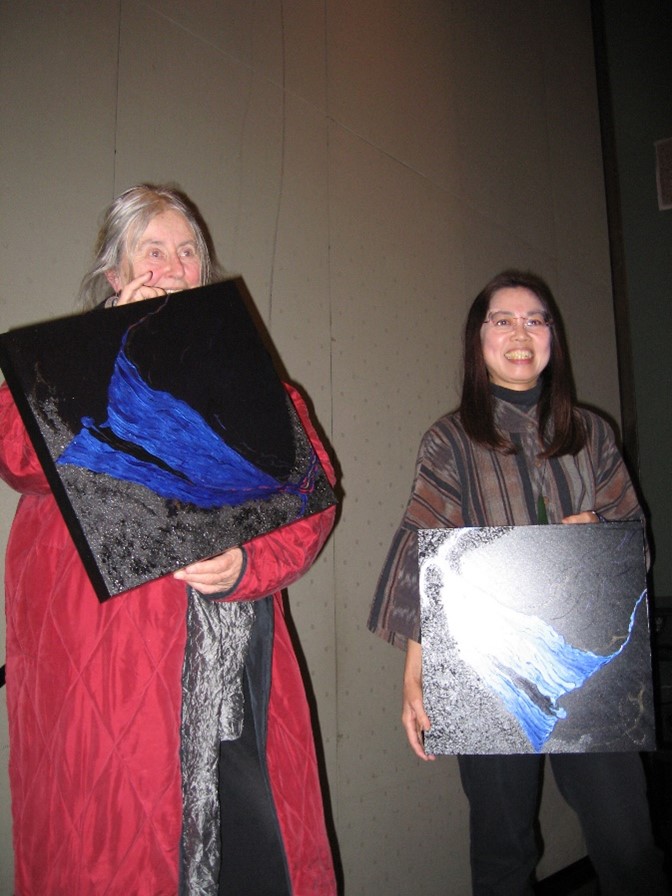
Photo of the 2006 CWA Award recipients, Moira Roth and Trinh T. Minh-ha holding paintings
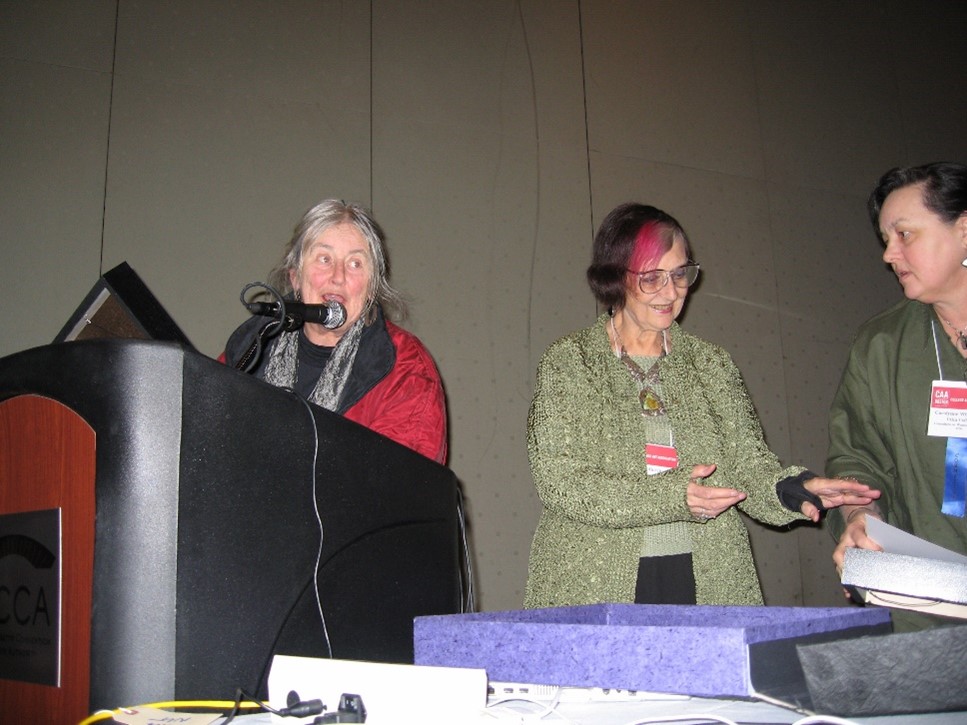
Moira (left) talking at the podium while Eleanor Dickinson (middle), then chair of CWA getting ready with the award gift created by Carolyne Manosevitz
In 2006, during the CAA Annual Conference in Boston, the Committee on Women in the Arts (CWA) honored Moira Roth (Trefethen Professor of Art History at Mills College in Oakland, CA) and Trinh T. Minh-ha (Professor of Women’s Studies and Rhetoric/Film at the University of California at Berkeley) with the CWA Annual Recognition Awards. Then CWA member, Carolyne Manosevitz, offered her own paintings as the award gifts. Roth, who recently passed away, was one of the first scholars to publish on feminist performance art. Her books, The Amazing Decade: Women in Performance Art in America (1983)and Rachel Rosenthal (1995), were groundbreaking. Minh-Ha is a Vietnam-born filmmaker, writer, and composer, whose practice is positioned within the fields of feminist and post-colonial studies.
After 2008, this award became a part of CAA’s Distinguished Awards program as the Distinguished Feminist Awards. The Distinguished Feminist Award is presented annually to a visual artist or designer who, through outstanding efforts in their practice or advocacy, has advanced the cause of equality for women in the arts; as well as a scholar who, through outstanding efforts in their scholarship, curatorial practice, or advocacy, has advanced the cause of equality for women in the arts. Read more about this award and its recipients here.
Post by Midori Yoshimoto
Midori Yoshimoto is associate professor of art history and gallery director at New Jersey City University. Yoshimoto specializes in post-1945 Japanese art and its diaspora with a focus on women artists, Fluxus, and intermedia. Her 2005 book, Into Performance: Japanese Women Artists in New York, led to numerous publications including an essay in Yoko Ono One Woman Show (Museum of Modern Art, New York, 2015). Yoshimoto co-curated a major survey exhibition of Japanese American artist Shigeko Kubota, which traveled three museums in Japan in 2021-22. Its catalog, Viva Video! The Art and Life of Shigeko Kubota was published by Kawade Shobo Shinsha and received the Ringa Art Encouragement Award in Japan. She is also a co-editor and author of a recent publication, Women, Aging, and Art: A Crosscultural Anthology (Bloomsbury, 2021).
In 1972, CAA founded its first committees devoted to women in the arts. As a part of this yearlong 50th anniversary celebration, we are sharing historic materials from CAA members and archives that intersect with feminism at the organization, including CAA’s Committee on Women in the Arts (CWA) and our Affiliated Societies, Women’s Caucus for Art (WCA) and The Feminist Art Project (TFAP).
This celebration culminates in a program and reception at Boston University’s Joan and Edgar Booth Theatre on Friday, September 23, 2022. This program will reflect upon the incredible history of feminist pioneers at the organization while looking toward a more inclusive, equitable future through the continued work of the CWA. The members of CWA are carrying the torch of feminism during this crucial time of precarity for women’s rights.
Over the next couple months, visit this site (CAA News) and our social media pages to explore more about this history and items from our archives.
Countering Feminist Indifference: Notes from the Women’s Caucus for Art
posted by CAA — August 15, 2022
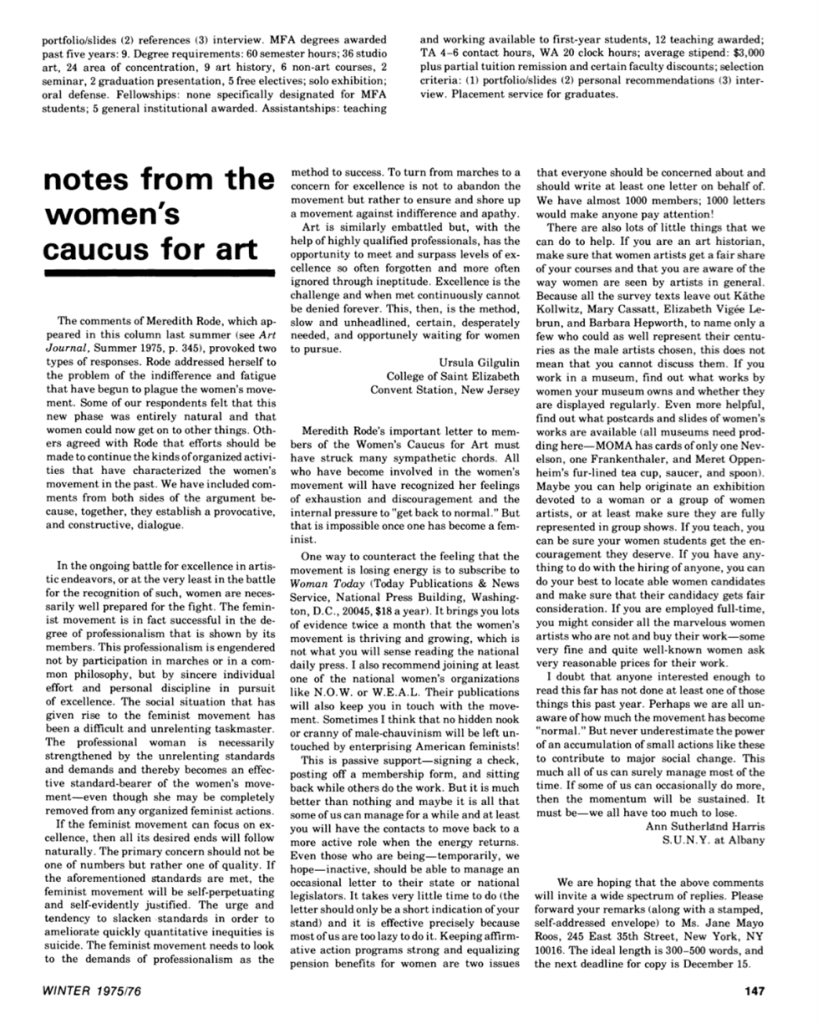
See full text reproduced below. Article also available on Jstor.
“Notes from the Women’s Caucus for Art (WCA),” a column featured in Art Journal during the 1970s, created an important forum for critical debates in the feminist art movement. In Summer 1975, for example, Meredith Rode shared evidence of fatigue with the feminist struggle in her letter “The High Price of Indifference.” Rode’s letter generated numerous responses in the winter 1975 issue, including Ann Sutherland Harris’s practical advice on how to counter this exhaustion.
The first President of WCA advocated both passive and activist gestures, ranging from sending a check to the National Organization of Women to pressuring local museums to display works by women in their collections, organizing group shows of women artists, mentoring female students, and buying women’s art.
This snapshot of WCA’s essential role in feminism art and activism reminds us how we can individually act to demand equity while working in conjunction with the collective efforts of essential national organizations, such as WCA and CAA. Read the full text below.
Post by Joanna Gardner-Huggett
Sources:
- Meredith Rode, “Notes from the Women’s Caucus for Art: The High Price of Indifference,” Art Journal (Summer 1975): 345.
- Ann Sutherland Harris, “Notes from the Women’s Caucus for Art,” Art Journal (Winter 1975/76): 147.
Biography of post author: Joanna Gardner-Huggett is an Associate Professor of History of Art and Architecture at DePaul University and Chair of the Committee on Women in the Arts. She teaches courses on twentieth-century art and feminist theory, while her research focuses on the intersection between feminist collaboration and arts activism and has been published in numerous journals and anthologies. Joanna’s most recent scholarship explores the history of the Chicago based women artists’ collectives Artemisia Gallery in Chicago (1973-2003), ARC Gallery (1973-present), and Sapphire and Crystals (1987-present).
FULL TEXT (from image): Ann Sutherland Harris, “Notes from the Women’s Caucus for Art,” Art Journal (Winter 1975/76): 147.
The comments of Meredith Rode, which appeared in this column last summer (see Art Journal, Summer 1975, p. 345), provoked two types of responses. Rode addressed herself to the problem of the indifference and fatigue that have begun to plague the women’s movement. Some of our respondents felt that this new phase was entirely natural and that women could now get on to other things. Other agreed with Rode that efforts should be made to continue the kinds of organized activities that have characterized the women’s movement in the past. We have included comments from both sides of the argument because, together, they establish a provocative, and constructive, dialogue.
In the going battle for excellence in artistic endeavors, or at the very least in the battle for the recognition of such, women are necessarily well prepared for the fight. The feminist movement is in fact successful in the degree of professionalism that is shown by its members. This professionalism is engendered not by participation in marches or in a common philosophy, but by sincere individual effort and personal discipline in pursuit of excellence. The social situation that has given rise to the feminist movement has been a difficult and unrelenting taskmaster. The professional woman is necessarily strengthened by the unrelenting standards and demands and thereby becomes an effective standard-bearer of the women’s movement—even though she may be completely remove from any organized feminist actions.
If the feminist movement can focus on excellence, then all its desire ends will follow naturally. The primary concern should not be one of the numbers but rather one of quality. If the aforementioned standards are met, the feminist movement will be self-perpetuating and self-evidently justified. The urge and tendency to slacken standards in order to ameliorate quickly quantitative inequities is suicide. The feminist movement needs to look to the demands of professionalism as the method to success. To turn from marches to a concern for excellence is not to abandon the movement but rather to ensure and shore up a movement against indifference and apathy.
Art is similarly embattled but, with the help of highly qualified professionals, has the opportunity to meet and surpass levels of excellence so often forgotten and more often ignored through ineptitude. Excellence is the challenge and when met continuously cannot be denied forever. This, then, is the method, slow and unheadlined, certain, desperately needed, and opportunely waiting for women to pursue.
Ursela Gilgulin, College of Saint Elizabeth, Convent Station, New Jersey
Meredith Rode’s important letter to members of the Women’s Caucus for Art must have struck many sympathetic chords. All who have become involved in the women’s movement will have recognized her feelings of exhaustion and discouragement and the internal pressure to “get back to normal.” But that is impossible once one has become a feminist.
One way to counteract the feeling that the movement is losing energy is to subscribe to Women Today. It brings you lots of evidence twice a month that the women’s movement is thriving and growing, which is not what you will sense reading the national daily press. I also recommend joining at least one of the national women’s organizations like N.O.W. or W.E.A.L. Their publications will also keep you in touch with the movement. Sometimes I think that no hidden nook or cranny of male-chauvinism will be left untouched by enterprising American feminists!
This is pass support—signing a check, posting off a membership form, and sitting back while others do the work. But it is much better than nothing and maybe it is all that some of us can manage for a while and at least you will have the contacts to move back to a more active role when the energy returns. Even those who are being—temporarily, we hope—in active, should be able to manage an occasional letter to their state or national legislators. It takes very little time to do (the letter should only be a short indication of your stand) and it is effective precisely because most of us are too lazy to do it. Keeping affirmative action programs strong and equalizing pension benefits for women are two issues that everyone should be concerned about and should write at least one letter on behalf of. We have almost 1000 members; 1000 letters would make anyone pay attention!
There are also lots of little things that we can do to help. If you are an art historian, make sure that women artists get a fair share of your courses and that you are aware of the way women are seen by artists in general. Because all the survey texts leave out Käthe Kollwitz, Mary Cassatt, Élisabeth Louise Vigée Le Brun, and Barbara Hepworth, to name only a few who could as well represent their centuries as the male artists chosen, this does not mean that you cannot discuss them. If you work in a museum, find out what works by women your museum owns and whether they are displayed regularly. Even more helpful, find out what postcards and slides of women’s works are available (all museums need prodding here—MOMA has cards of only one Nevelson, one Frankenthaler, and Meret Oppenheim’s fur-lined tea cup, saucer, and spoon). Maybe you can help originate an exhibition devoted to a woman or a group of women artists, or at least make sure they are fully represented in group shows. If you teach, you can be sure your women students get the encouragement they deserve. If you have anything to do with the hiring of anyone, you can do your best to locate able women candidates and makes sure that their candidacy gets fair consideration. If you are employed full-time, you might consider all the marvelous women artists who are not and buy their work—some very fine and quite well-known women ask very reasonable prices for their work.
I doubt that anyone interested enough to read this far has not done at least one of these things this past year. Perhaps we are all unaware of how much the movement has become “normal.” But never underestimate the power of an accumulation of small actions like these to contribute to major social change. This much all of us can surely manage most of the time. If some of us can occasionally do more, then the momentum will be sustained. It must be—we all have too much to lose.
Ann Sutherland Harris, S.U.N.Y at Albany
In 1972, CAA founded its first committees devoted to women in the arts. As a part of this yearlong 50th anniversary celebration, we are sharing historic materials from CAA members and archives that intersect with feminism at the organization, including CAA’s Committee on Women in the Arts (CWA) and our Affiliated Societies, Women’s Caucus for Art (WCA) and The Feminist Art Project (TFAP).
This celebration culminates in a program and reception at Boston University’s Joan and Edgar Booth Theatre on Friday, September 23, 2022. This program will reflect upon the incredible history of feminist pioneers at the organization while looking toward a more inclusive, equitable future through the continued work of the CWA. The members of CWA are carrying the torch of feminism during this crucial time of precarity for women’s rights.
Over the next couple months, visit this site (CAA News) and our social media pages to explore more about this history and items from our archives.
The Women’s Caucus of Art’s 1994 Honors Awards Exhibition at the Queens Museum
posted by CAA — August 08, 2022
The Women’s Caucus of Art (WCA) began at CAA in 1972 and broke off to become an independent organization in 1974. Their mission is to create community through art, education, and social activism. recognizing the contribution of women in the arts; providing women with leadership opportunities and professional development; expanding networking and exhibition opportunities for women; supporting local, national and global art activism; and advocating for equity in the arts for all. The organization is still active with many local branches and as an Affiliated Society of CAA holds an annual meeting held in conjunction with CAA. It has awarded prizes for lifetime achievement to many of the (now) best-known American women artists, beginning in 1978 with Isabel Bishop, Louise Nevelson, Georgia O’Keeffe, Selma Burke, and Alice Neel.
Each year since 1979, the WCA presented an exhibition of honorees’ work in conjunction with their national conference. In 1994, the exhibition took place at the Queens Museum of Art, showing work by Mary Adams, Maria Enriques de Allen, Beverly Pepper, Faith Ringgold, Rachel Rosenthal, and Charlotte Streifer Rubinstein. Ringgold and Rubinstein were active WCA members at the time.
Explore the exhibition through archival photographs below!
All images courtesy of the Queens Museum, New York.
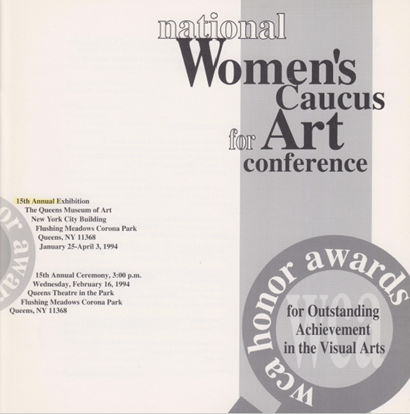
Cover of the WCA catalog for the 1994 exhibit at the Queens Museum of Art. See more WCA exhibition catalogs on their website.
 Opening of WCA’s 1994 exhibition at the Queens Museum of Art. Quilt works by honoree, Faith Ringgold.
Opening of WCA’s 1994 exhibition at the Queens Museum of Art. Quilt works by honoree, Faith Ringgold.
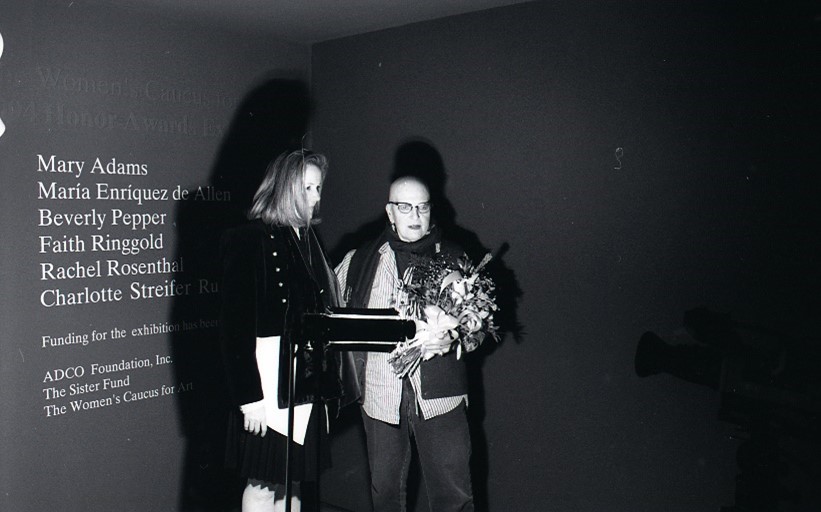
Opening of WCA’s 1994 exhibition at the Queens Museum of Art. Rachel Rosenthal (right) was the first performance artist ever to be a WCA Honoree.
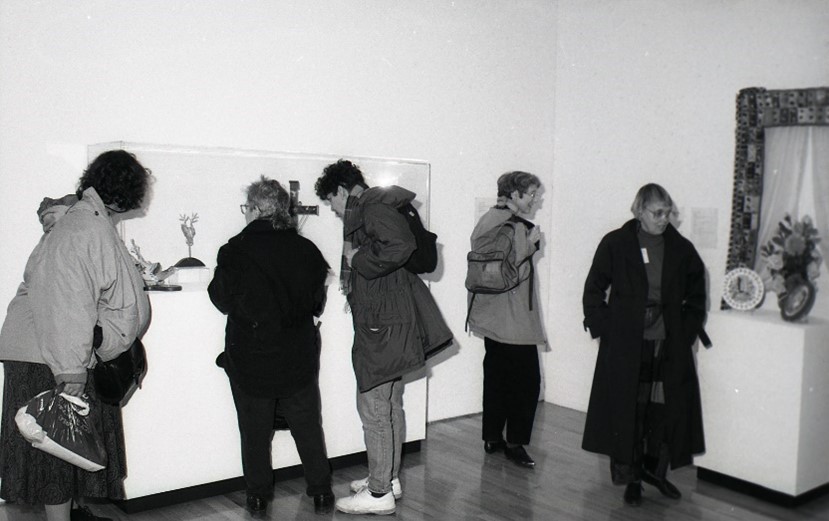
Opening of WCA’s 1994 exhibition at the Queens Museum of Art.
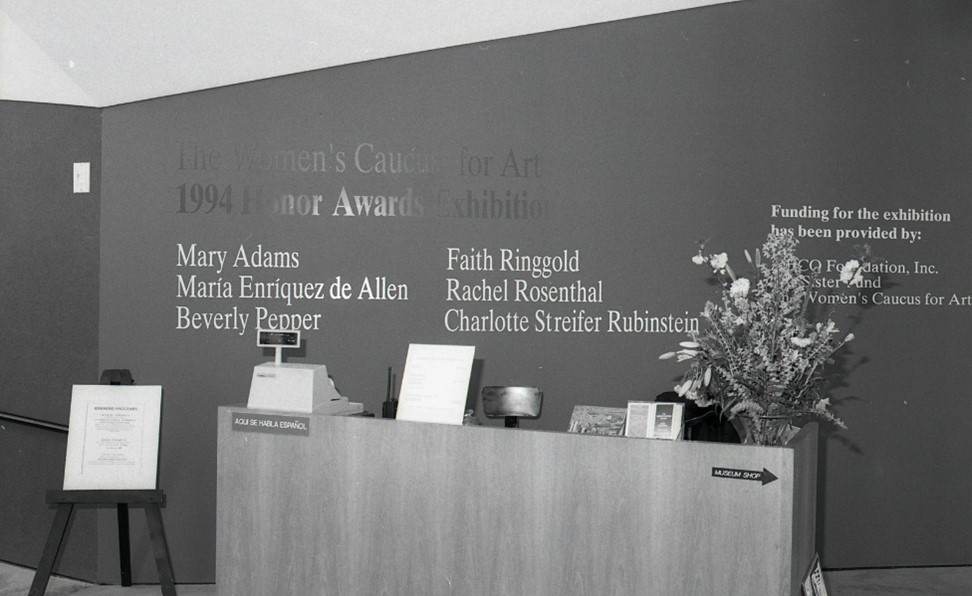 Opening of WCA’s 1994 exhibition at the Queens Museum of Art.
Opening of WCA’s 1994 exhibition at the Queens Museum of Art.
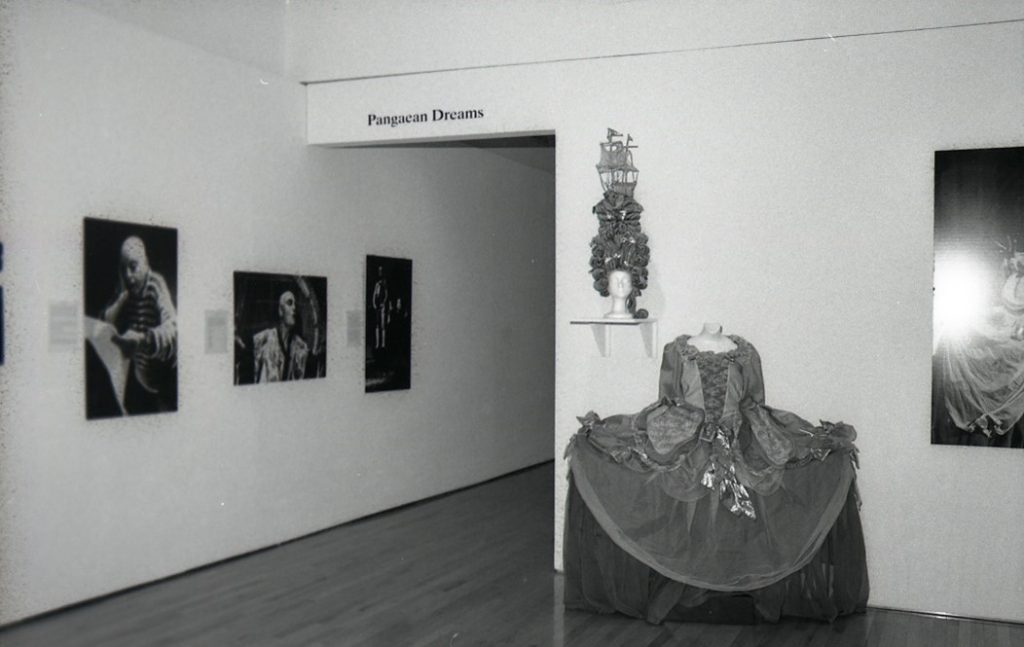 Opening of WCA’s 1994 exhibition at the Queens Museum of Art.
Opening of WCA’s 1994 exhibition at the Queens Museum of Art.
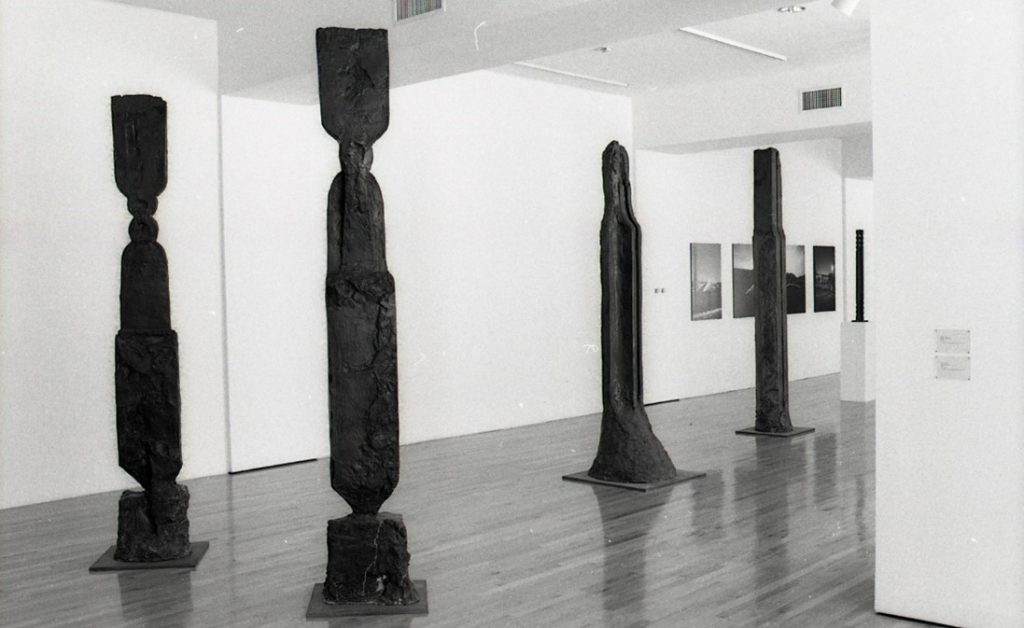 Opening of WCA’s 1994 exhibition at the Queens Museum of Art. Award recipient, Beverly Pepper’s work, The Todi Columns, 1979.
Opening of WCA’s 1994 exhibition at the Queens Museum of Art. Award recipient, Beverly Pepper’s work, The Todi Columns, 1979.
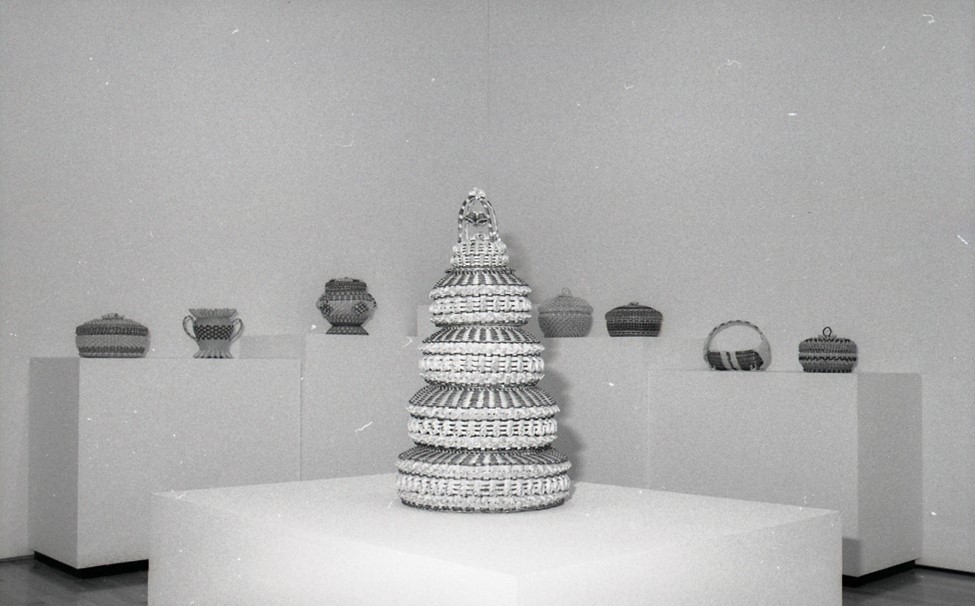 Opening of WCA’s 1994 exhibition at the Queens Museum of Art. Award recipient Mary Adams’s work, Wedding Cake Basket. Adams was the first Native American Honoree from the Mohawk Nation and had started making baskets when she was ten years old.
Opening of WCA’s 1994 exhibition at the Queens Museum of Art. Award recipient Mary Adams’s work, Wedding Cake Basket. Adams was the first Native American Honoree from the Mohawk Nation and had started making baskets when she was ten years old.
In 1972, CAA founded its first committees devoted to women in the arts. As a part of this yearlong 50th anniversary celebration, we are sharing historic materials from CAA members and archives that intersect with feminism at the organization, including CAA’s Committee on Women in the Arts (CWA) and our Affiliated Societies, Women’s Caucus for Art (WCA) and The Feminist Art Project (TFAP).
This celebration culminates in a program and reception at Boston University’s Joan and Edgar Booth Theatre on Friday, September 23, 2022. This program will reflect upon the incredible history of feminist pioneers at the organization while looking toward a more inclusive, equitable future through the continued work of the CWA. The members of CWA are carrying the torch of feminism during this crucial time of precarity for women’s rights.
Over the next couple months, visit this site (CAA News) and our social media pages to explore more about this history and items from our archives.
History of CAA’s Committee on Women in the Arts (CWA)
posted by CAA — July 29, 2022
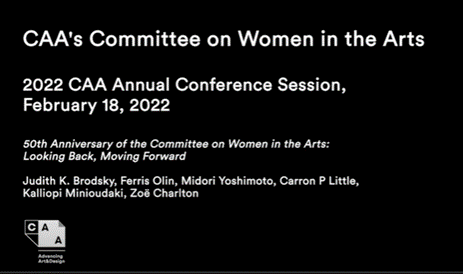
At CAA’s 2022 Annual Conference, current and former members of the Committee on Women in the Arts (CWA) presented a session on the history of feminism at CAA and within their committee entitled “50 Years of Feminist Art at CAA: Looking Back, Looking Forward.” Watch the video below to hear a series of talks on this history.
50 Years of Feminist Art at CAA: Speakers
Chair: Joanna P. Gardner-Huggett, DePaul University
Judith K. Brodsky, Pennsylvania Academy of Fine Arts
Ferris Olin, Rutgers University
Midori Yoshimoto, New Jersey City University
Carron P. Little, School of the Art Institute of Chicago
Kalliopi Minioudaki, Independent Scholar and Curator
Zoë Charlton, American University
Abstract: Fifty years ago, the Committee on Women in the Arts was founded to promote the recognition of women’s valuable contribution to the visual arts and to critical art-historical study; advocate for feminist scholarship and activism in art; develop partnerships with organizations with compatible missions; monitor the status of women in the visual-arts professions; provide historical and current resources on feminist issues; and support emerging artists and scholars in their careers. In 2020, the CWA implemented the 50/50 initiative, which aims for 50% representation of women scholars and artists at the CAA Annual Conference and intersectional feminist content inclusive of race, class, gender, body size, disability, or age. At this significant juncture, this session proposes to reflect on the committee’s history by inviting previous members and chairs to discuss their work with the CWA, as well as collaborations with other affiliate committees and groups, such as the Women’s Caucus for Art, The Feminist Art Project, the Queer Caucus, and many more. In addition to assessing CWA’s past contributions, the panel will engage in a conversation of what work remains to be done.
In 1972, CAA founded its first committees devoted to women in the arts. As a part of this yearlong 50th anniversary celebration, we are sharing historic materials from CAA members and archives that intersect with feminism at the organization, including CAA’s Committee on Women in the Arts (CWA) and our Affiliated Societies, Women’s Caucus for Art (WCA) and The Feminist Art Project (TFAP).
This celebration culminates in a program and reception at Boston University’s Joan and Edgar Booth Theatre on Friday, September 23, 2022. This program will reflect upon the incredible history of feminist pioneers at the organization while looking toward a more inclusive, equitable future through the continued work of the CWA. The members of CWA are carrying the torch of feminism during this crucial time of precarity for women’s rights.
Over the next couple months, visit this site (CAA News) and our social media pages to explore more about this history and items from our archives.
CAA’s 50th Anniversary Celebration of Feminism + Art
posted by CAA — July 29, 2022
In 1972, CAA founded its first committees devoted to women in the arts. As a part of this yearlong 50th anniversary celebration, we are sharing historic materials from CAA members and archives that intersect with feminism at the organization, including CAA’s Committee on Women in the Arts (CWA) and our Affiliated Societies, Women’s Caucus for Art (WCA) and The Feminist Art Project (TFAP).
This celebration culminates in a program and reception at Boston University’s Joan and Edgar Booth Theatre on Friday, September 23, 2022. This program will reflect upon the incredible history of feminist pioneers at the organization while looking toward a more inclusive, equitable future through the continued work of the CWA. The members of CWA are carrying the torch of feminism during this crucial time of precarity for women’s rights.
Over the next couple months, visit this site (CAA News) and our social media pages to explore more about this history and items from our archives.
CAA Museum Committee: Call for Professionals
posted by CAA — July 12, 2022
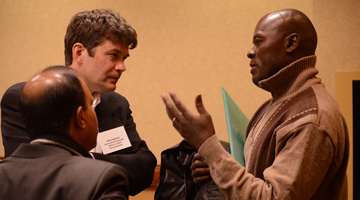
The CAA Museum Committee seeks CAA, AAM, AAMG, other professional organization members, and/or museum studies educators, to join the review process to revise the CAA Tools for Museum Professionals. The asynchronous review of seven standards and guidelines will begin in late summer and continue through the fall. Contributor credit will be included in the authors byline of the revised standards and guidelines document(s) following their approval.
Topics for review include:
- Curriculum Vitae for Museum Professionals
- Guidelines for Museums or Other Not-For-Profit Visual-Arts Institutions Working with Artists on Exhibitions and Commissioned Works
- Guidelines Regarding the Hiring of Guest Curators by Museums
- Information about Museum Ethics and Professional Practices
- Professional Practices for Art Museum Curators
- Statement Concerning the Acquisition of Cultural Properties Originating from Abroad, from Indigenous Cultures, and from Private Collections during the Nazi Era
- Statement Concerning the Deaccession of Works of Art
Please email a letter of interest with a short statement about your experience and expertise to Monica Andrews, contactstudiomda@gmail.com. Deadline: August 17.


